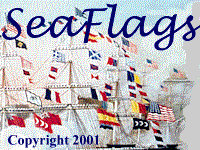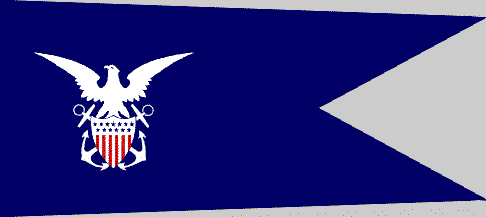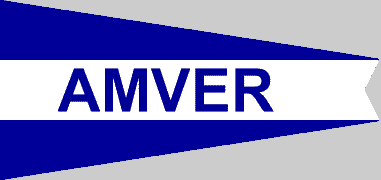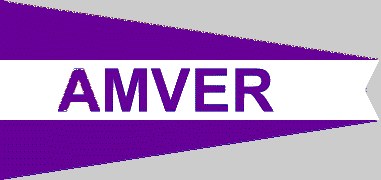 |
United States Merchant Marine
|
U.S. Merchant Marine Flag

On this page:
See also:
Return to Sea Flags home page
About the U.S. Merchant Marine Flag
This flag, intended to commemorate the past and present contributions of
merchant seamen to the security and prosperity of the United States, was
introduced by the Maritime Administration of the Department of Transportation
on May 24, 1994. For parade and indoor display, it is either 52 by
66 inches (as shown) or 36 by 48 inches, and trimmed with golden yellow
fringe. The flag is also produced in bunting in the 36 by 48 inch
size (without fringe) to be hoisted on a fixed outdoor pole. It is
displayed in this form at the U.S. Navy Memorial in Washington, D.C.
Return to top of page
Rules of Flag Usage in the Merchant Marine
Although never prescribed by law or regulation, the following set of guidelines set forth by
the U.S. Merchant Marine Council in 1950 provide an authoritative statement of the customary rules.
In the United States:
Daily: All flags are raised daily at 8:00 a.m., the ensign
being hoisted at the stern flagstaff before any others. The jack is hoisted at the jackstaff on
vessels affiliated with the Naval Reserve. The house flag is hoisted at
the truck of the mainmast. When the rules were published, the
Naval Reserve Merchant Marine pennant was flown above the house flag by ships entitled to it; today
it is flown at the starboard yardarm instead. All flags are hauled down at sunset.
When dressing ship: On holidays and the like, the ship is dressed with a string of signal flags and
pennants from stem to stern, with an extra U.S. ensign at the foremast.
On sailing day: Flags are hoisted at 8:00 as usual, with the flag of the country of destination at the
truck of the foremast, the "blue Peter" at the starboard
yardarm, and the now-obsolete U.S. Mail flag, if carrying mail, at the port yardarm. If the Naval
Reserve pennant is flying, the blue Peter is flown at the triatic stay. The flag for "H" in the International Code of Signals,, signaling that
the pilot is aboard, flies at any convenient
halyard. As soon as the last mooring line is cast off, the ensign is shifted to the gaff and the jack and
blue peter are lowered. All but the pilot flag are hauled down at sunset.
On arriving at a U.S. port: Before reaching the pilot station, the ensign is hoisted to the gaff, the
ensign of the country the ship sailed from (other than the United States) to the fore truck, the house flag
to the main truck, the Naval Reserve pennant to the starboard yardarm and the mail flag to the port yardarm,
and the G signal flag, the signal to call a pilot, at the triatic
stay. Before reaching the quarantine station, the yellow Q flag
is hoisted; once pratique--public health clearance--is granted, the Q flag is hauled down before the
ship reaches the berth. The national ensign is shifted from the gaff to the flagstaff when the first
line is ashore, and the jack is hoisted if appropriate.
In a Foreign Country:
On arriving: The same procedure as for arriving at a U.S. port, except that the flag of the country being
entered must always be hoisted at the foremost truck and left flying at all times during daylight hours, from
8:00 a.m. to sunset while in that port.
When dressing ship: The same as in a U.S. port, but with the foreign ensign instead of the second
U.S. ensign at the fore.
On departure: The same procedure as for sailing from a U.S. port, but with the host state's ensign at
the fore truck.
Saluting Warships: When passing a warship of any country recognized by the United States,
including Coast Guard cutters, the merchant ship's U.S. ensign is lowered halfway down the gaff halyard or halfway down the
flagstaff when the two ships come abeam of each other. When the warship returns the salute by dipping its
ensign briefly, the merchant vessel hoists its ensign full up and proceeds.
Return to top of page
Merchant Marine Naval Reserve

The Naval Reserve Merchant Marine pennant is flown at a signal halyard
in port aboard ships that have been warranted by the Secretary of the Navy
to be suitable for wartime use as naval auxiliaries. The master of
the ship and at least half of its licensed officers must be members of
the U.S. Naval Reserve. The pennant was originally prescribed by
Navy Department General Order 285, dated April 14, 1917. The current
statutory authorization for the pennant is contained in Title 10, U.S.
Code, section 7225.
Return to top of page
AMVER Program
The Automoted Mutual-assistance Vessel Rescue System (AMVER) is a voluntary
program under which merchant vessels of any country report their positions
to the U.S. Coast Guard on a continuing basis for the purpose of facilitating
emergency response--either to an emergency aboard the reporting vessel
or, more to the point, so that the Coast Guard will be able to vector vessels
in the area more expeditiously to respond to a call for help from another
craft. It was originally known as the Atlantic Marine Vessel Emergency
Reporting System. Merchant ships that participate in the program
for prescribed periods of time are eligible to display AMVER pennants.
To qualify, a ship must be on the Coast Guard's AMVER plot at least 128
days out of a calendar year. A vessel that meets this standard in
a given calendar year receives a blue pennant. One that qualifies
for five consecutive years receives a gold pennant, and a ship that participates
for ten consecutive years a purple pennant. Overhaul periods do not
break the qualification for the gold and purple pennant, provided the time
in the yard is less than two years and the ship is a continuous participant
before and after the yard period. In 1998, 4,095 ships from 143 nations
qualified for one of these awards out of some 12,000 total participants--about
40% of the worldwide merchant fleet. During that year, there were
an average of 2,776 ships on the AMVER plot on any given day and the system
was responsible for saving 238 lives.

1-year pennant

5-year pennant

10-year pennant
Return to top of page
Return to Sea Flags home page
Sea
Flags
Copyright 2000, 2001 by Joseph McMillan

